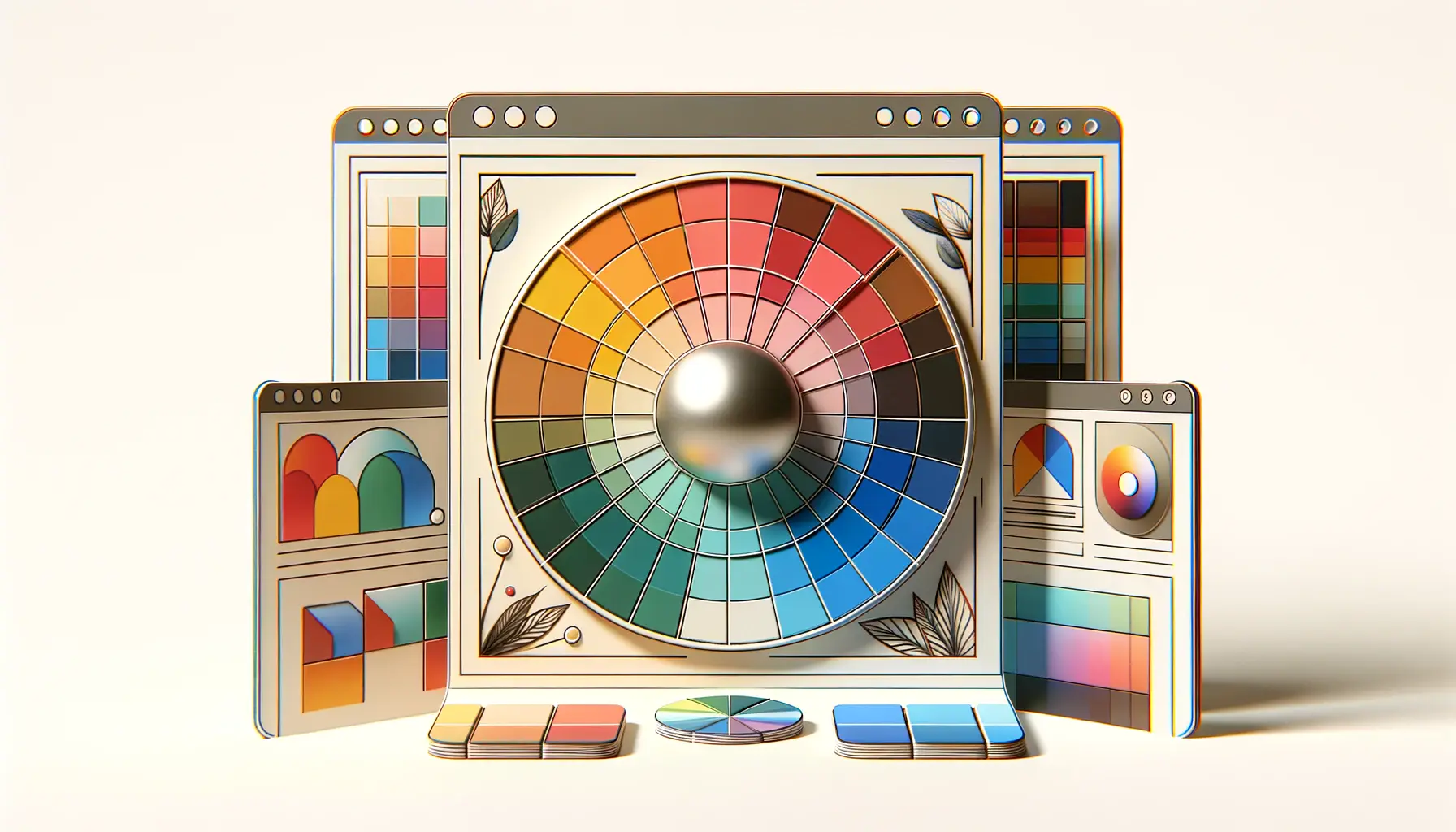Understanding color theory and its impact on accessibility is crucial in the realm of web design.
The way we perceive colors not only influences our aesthetic appreciation but also affects our ability to interact with digital interfaces effectively.
Inclusive design aims to accommodate the diverse visual needs of users, ensuring that digital products are accessible to as many people as possible, including those with visual impairments or color vision deficiencies.
This article delves into the intersection of color theory and accessibility, offering insights and strategies to create more inclusive digital environments.
The significance of color in web design cannot be overstated.
It goes beyond mere decoration to serve as a powerful tool for communication, conveying messages, and guiding user interaction.
However, when designers fail to consider accessibility, the choice of colors can create barriers for a significant portion of the user base.
By integrating principles of color theory and accessibility, designers can craft experiences that are not only visually appealing but also universally usable, fostering an inclusive digital world.
- Understanding Color Theory
- Principles of Accessibility in Design
- Color Accessibility Tools and Resources
- Inclusive Design Practices
- Challenges and Solutions in Achieving Color Accessibility
- Impact of Color Accessibility on User Experience
- Future Trends in Color Accessibility
- Embracing the Future of Inclusive Design
- FAQs on Color Theory and Accessibility
Understanding Color Theory
Basics of Color Theory
At the heart of color theory lies the color wheel, a visual representation of colors arranged according to their chromatic relationship.
Primary colors (red, blue, and yellow) combine to create secondary colors (green, orange, and purple), which in turn blend to form tertiary colors.
This systematic approach helps designers understand how different colors interact, influence each other, and affect the viewer’s perception and emotions.
Color theory encompasses various concepts such as hue, saturation, and brightness, each playing a pivotal role in creating visually harmonious designs.
Hue refers to the color itself, saturation to the intensity of the color, and brightness to how light or dark a color appears.
Understanding these elements is essential for designers to make informed decisions about color schemes that enhance readability and user experience.
Color Harmony and Contrast
Color harmony is achieved when colors are combined in a way that is pleasing to the eye, creating a balanced and cohesive look.
This can be accomplished through analogous, complementary, or triadic color schemes, each offering different levels of contrast and vibrancy.
High contrast color combinations are particularly important in accessibility, as they ensure that text and interactive elements stand out against their backgrounds, making them easier to read and interact with for users with low vision or color vision deficiencies.
Contrast ratio is a key factor in accessibility, with guidelines suggesting a minimum contrast ratio for text and background colors to ensure legibility.
Designers can use tools to calculate these ratios, ensuring their designs meet accessibility standards and are more inclusive.
By applying principles of color harmony and contrast, designers can create aesthetically pleasing designs that also cater to a wider audience.
Incorporating color theory into web design enhances both the aesthetic appeal and the usability of digital products, making them accessible to a broader range of users.
Principles of Accessibility in Design
Accessibility in web design ensures that digital products are usable by everyone, including individuals with disabilities.
This encompasses a wide range of conditions, including visual, auditory, motor, and cognitive impairments.
Designing for accessibility involves understanding these challenges and implementing strategies to overcome them.
Here, we focus on the visual aspects of accessibility, particularly how color choices can impact users with different types of color vision deficiencies.
Color vision deficiency (CVD), often referred to as color blindness, affects a significant portion of the population.
This condition varies widely, from difficulty distinguishing between certain colors to an inability to see color at all.
The most common forms of CVD are Deuteranomaly, Protanomaly, and Tritanomaly, each affecting the perception of green, red, and blue light, respectively.
Designers must consider these variations when choosing color schemes for web and digital interfaces.
Key Accessibility Guidelines for Color Use
- Ensure sufficient contrast: Text and background colors should have enough contrast to be easily distinguishable by all users, including those with CVD or low vision. The Web Content Accessibility Guidelines (WCAG) recommend a minimum contrast ratio of 4.5:1 for normal text and 3:1 for large text.
- Avoid color as the sole means of communication: Information conveyed through color alone can be missed by users with color vision deficiencies. Use textures, patterns, or labels in addition to color to communicate important information.
- Test your design with CVD simulation tools: Numerous tools and software allow designers to simulate how their designs appear to users with various types of color vision deficiencies. This can help identify potential issues early in the design process.
Implementing these guidelines not only enhances the accessibility of a website but also improves its overall usability.
For instance, high contrast ratios benefit users in low-light conditions or on devices with low-quality screens.
Similarly, providing alternative ways to convey information helps all users understand content more effectively, regardless of their ability to perceive color.
Accessibility is not just a legal or ethical obligation; it’s a design opportunity to innovate and reach a wider audience by creating more inclusive digital experiences.
Color Accessibility Tools and Resources
Designers have access to a plethora of tools and resources that can aid in creating color-accessible designs.
These tools can help evaluate and adjust color schemes to meet accessibility standards, ensuring that digital content is perceivable by users with various types of visual impairments.
Utilizing these tools effectively can significantly enhance the inclusivity of web and digital interfaces.
Color contrast checkers are among the most valuable resources for designers.
These tools analyze the contrast ratio between text and its background, providing immediate feedback on whether the combination meets the recommended accessibility standards.
By integrating these checks into the design process, designers can ensure their color choices are accessible from the start.
Popular Color Accessibility Tools
- WebAIM Contrast Checker: A user-friendly tool that evaluates text and background color contrast on web pages against WCAG guidelines.
- Color Oracle: A free color blindness simulator for Windows, Mac, and Linux, allowing designers to view their designs as users with various color vision deficiencies would see them.
- Adobe Color: Offers a color wheel that includes accessibility tools to test color schemes for color blindness compatibility and contrast ratios.
Implementing Accessible Color Schemes
When selecting colors for a website or digital product, it’s crucial to start with an accessible color palette.
This involves choosing colors that not only work well together aesthetically but also provide sufficient contrast for text and interactive elements.
Designers should consider the emotional impact of colors, as well as how they will be perceived by users with color vision deficiencies.
It’s also important to test designs in various conditions, including on different devices and in different lighting conditions, to ensure that colors maintain their legibility and effectiveness.
By adopting an accessibility-first approach to color selection, designers can create more inclusive and user-friendly digital experiences.
Exploring and utilizing these tools and resources is a step forward in embracing accessibility in design, fostering an inclusive digital environment where everyone has equal access to information and functionality.
Inclusive Design Practices
Inclusive design goes beyond mere compliance with accessibility standards to embrace a broader vision of creating experiences that are usable and enjoyable for as wide an audience as possible.
It involves a deep understanding of user diversity, including the full range of human abilities, language, culture, and other forms of human difference.
In the context of color theory and web design, inclusive design practices ensure that digital products are not only accessible but also resonate with users on a deeper level.
Adopting an inclusive design approach means considering the myriad ways people interact with digital content.
This includes recognizing the importance of color in conveying information and emotion, and how it can be perceived differently by individuals with various types of visual impairments.
By prioritizing inclusivity from the outset, designers can create more empathetic and effective digital experiences.
Strategies for Inclusive Color Design
- User-Centered Research: Engage with a diverse group of users, including those with disabilities, to gather insights into how color choices affect their experience. This can inform more empathetic and effective design decisions.
- Flexible User Preferences: Allow users to customize color schemes according to their needs and preferences. This can include options for high contrast, dark mode, or color adjustments for those with color vision deficiencies.
- Comprehensive Testing: Test designs with a wide range of users, devices, and environments to ensure that color choices are effective and accessible under various conditions. This includes simulating different types of color vision deficiencies.
Incorporating these strategies into the design process can significantly enhance the inclusivity of digital products.
It not only ensures compliance with accessibility standards but also contributes to creating a more welcoming and user-friendly digital environment.
By embracing inclusive design practices, designers can make a positive impact on the lives of users, demonstrating a commitment to diversity and inclusion in the digital space.
Inclusive design recognizes diversity as a key aspect of the human experience, aiming to create digital products that are accessible, usable, and meaningful to as many people as possible.
Challenges and Solutions in Achieving Color Accessibility
Achieving color accessibility in web design presents a unique set of challenges.
Designers must balance aesthetic considerations with the need to ensure that their creations are accessible to users with a wide range of visual abilities.
This balancing act can sometimes lead to difficult decisions, especially when trying to maintain brand identity or when dealing with complex information visualizations.
However, by understanding these challenges and exploring innovative solutions, designers can overcome these hurdles and create designs that are both beautiful and accessible to all.
One of the primary challenges is ensuring that color schemes are accessible to users with color vision deficiencies without compromising the overall design quality.
This often requires a departure from traditional design practices and the exploration of new color combinations that are both aesthetically pleasing and accessible.
Additionally, maintaining accessibility across different devices and screen settings can further complicate the design process.
Strategies for Overcoming Accessibility Challenges
- Use of Text and Icons: Supplement color cues with text labels or icons to ensure that information is accessible to users with color vision deficiencies.
- Adaptive Designs: Implement responsive and adaptive design strategies that adjust to the user’s device and preferences, ensuring accessibility across a wide range of screen sizes and settings.
- Collaboration with Accessibility Experts: Work closely with accessibility consultants or organizations that specialize in visual impairments to validate design choices and ensure they meet accessibility standards.
By addressing these challenges head-on and employing creative solutions, designers can create digital experiences that are not only visually appealing but also inclusive.
This not only enhances the user experience for individuals with visual impairments but also benefits all users by providing clearer, more intuitive interfaces.
As the digital landscape continues to evolve, the importance of color accessibility in web design cannot be overstated.
It is a critical component of inclusive design that ensures digital products are welcoming and usable for everyone.
Embracing the challenges of color accessibility is an opportunity for designers to innovate and push the boundaries of what is possible in creating inclusive digital experiences.
Impact of Color Accessibility on User Experience
The impact of color accessibility on user experience is profound and multifaceted.
By ensuring that digital products are accessible to users with color vision deficiencies and other visual impairments, designers can significantly enhance usability, satisfaction, and engagement.
Color accessibility not only benefits users who require these considerations but also improves the overall clarity and effectiveness of web and digital interfaces for all users.
Accessible color schemes facilitate easier navigation and interaction with digital content, reducing cognitive load and preventing user frustration.
This is particularly important in environments where quick decision-making is essential, such as in online shopping, banking, or emergency services.
By prioritizing color accessibility, designers contribute to creating a more inclusive digital world where information and services are readily available to everyone, regardless of their visual capabilities.
Enhancing User Engagement Through Color Accessibility
- Increased Reach: Accessible designs cater to a wider audience, including the millions of users with color vision deficiencies. This inclusivity can lead to increased user base and higher engagement levels.
- Improved Brand Perception: Brands that prioritize accessibility are often viewed more favorably by consumers, as they demonstrate a commitment to inclusivity and social responsibility.
- Higher Satisfaction and Loyalty: Users are more likely to return to and recommend websites that are accessible and easy to use, leading to higher customer satisfaction and loyalty.
Implementing color accessibility is a strategic investment in the user experience that pays dividends in terms of engagement and brand loyalty.
It reflects an understanding of the diverse needs of the user base and a commitment to meeting those needs.
As digital spaces become increasingly central to our daily lives, the importance of designing with accessibility in mind cannot be overstated.
Color accessibility is a key component of this effort, ensuring that digital experiences are inclusive, engaging, and effective for everyone.
Neglecting color accessibility can lead to a narrow user experience, excluding a significant portion of the potential audience and diminishing the overall effectiveness of digital products.
Future Trends in Color Accessibility
The future of color accessibility in web design is promising, with emerging technologies and evolving standards paving the way for more inclusive digital experiences.
As awareness of accessibility issues grows, designers and developers are increasingly prioritizing inclusivity in their projects.
This shift is driven by a combination of ethical considerations, legal requirements, and the recognition of the untapped potential of a more diverse user base.
Looking forward, several trends are likely to shape the landscape of color accessibility in web design.
Advancements in artificial intelligence (AI) and machine learning (ML) are set to offer new tools for enhancing color accessibility.
These technologies can automate the process of testing and adjusting color schemes to meet accessibility standards, reducing the time and effort required from designers.
Additionally, AI can provide personalized color adjustments for users with specific visual impairments, creating a customized viewing experience that maximizes accessibility and usability.
Innovations in User Customization and Control
- Personalized Accessibility Profiles: Future web platforms may allow users to create personalized accessibility profiles that automatically adjust color schemes and other design elements to suit their individual needs.
- Dynamic Color Adjustment Tools: New tools and browser extensions could enable users to dynamically adjust color settings on any website, giving them greater control over their viewing experience.
- Enhanced Standards and Guidelines: Ongoing updates to accessibility standards, such as the Web Content Accessibility Guidelines (WCAG), will continue to refine and expand recommendations for color use in digital content.
As these trends develop, the role of color in web design will continue to evolve, with a greater emphasis on flexibility, personalization, and inclusivity.
The future of color accessibility looks bright, with the potential to create digital experiences that are more accessible, engaging, and satisfying for all users.
By staying abreast of these trends and incorporating them into their work, designers and developers can contribute to a more inclusive digital world.
The ongoing evolution of color accessibility practices reflects a broader shift towards more inclusive and user-centered design philosophies, promising a future where digital experiences are accessible to everyone, regardless of their visual abilities.
Embracing the Future of Inclusive Design
As we delve into the complexities and nuances of color theory and accessibility, it becomes evident that the journey towards creating inclusive digital environments is both challenging and rewarding.
The integration of accessibility into the fabric of web design is not just a matter of compliance or ethical obligation; it is a testament to the evolving understanding of diversity and inclusion in the digital age.
The principles and practices discussed throughout this article underscore the importance of designing with empathy, ensuring that digital products are accessible, usable, and enjoyable for everyone.
The Path Forward
The future of web design is inherently linked to the principles of inclusivity and accessibility.
As designers and developers, the responsibility lies in our hands to pave the way for a digital world that acknowledges and accommodates the full spectrum of human diversity.
The trends in color accessibility and inclusive design practices offer a glimpse into a future where digital experiences are tailored to meet the needs of all users, regardless of their visual capabilities or other disabilities.
Key Takeaways for Designers
- Understanding and applying color theory is crucial for creating accessible and aesthetically pleasing designs.
- Incorporating accessibility guidelines from the outset of the design process is essential for developing inclusive digital products.
- Utilizing tools and resources for color accessibility can significantly enhance the usability and inclusivity of web designs.
- Embracing innovative technologies and trends will be key to advancing the inclusivity of digital environments in the future.
In conclusion, the intersection of color theory and accessibility presents an opportunity for designers to rethink how digital experiences are crafted.
By prioritizing accessibility and inclusivity, we can create a digital world that is not only visually appealing but also universally accessible.
The journey towards inclusive design is ongoing, and it is up to us to continue exploring, learning, and implementing the best practices that will define the future of digital accessibility.
Quality web design is key for a great website! Check out our service page to partner with an expert web design agency.
FAQs on Color Theory and Accessibility
Explore common questions about integrating color theory with accessibility in design to create inclusive digital experiences.
Color theory in design explores how colors interact, their visual effects, and how they influence user perception and emotions.
Accessibility ensures digital products are usable by everyone, including those with disabilities, enhancing usability and inclusivity.
Color choices can impact legibility and the ability of users, especially those with visual impairments, to interact with content.
Best practices include sufficient contrast, not using color alone for information, and testing designs for color vision deficiencies.
Yes, applying color theory can enhance aesthetic appeal and emotional resonance, improving overall user engagement and satisfaction.
Tools like contrast checkers and color blindness simulators assist in evaluating and improving color schemes for accessibility.
Use accessibility evaluation tools to simulate how users with color vision deficiencies perceive your design, ensuring inclusivity.
The future includes advancements in technology and standards, focusing on personalization and greater inclusivity in digital design.











